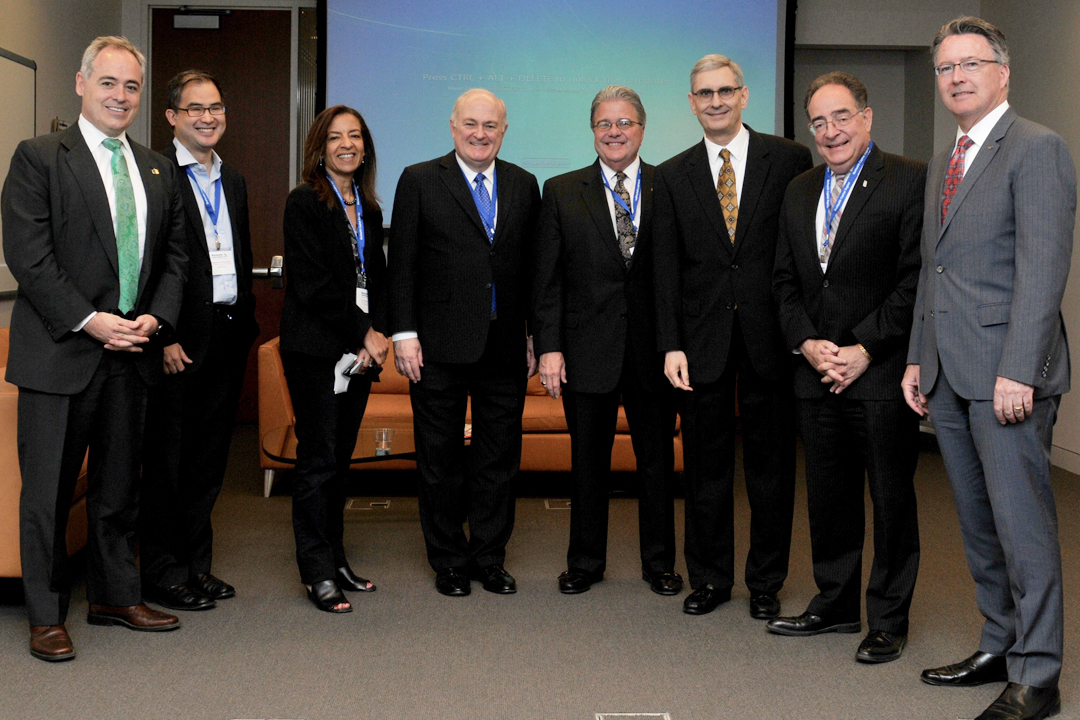George Washington President Steven Knapp, speaking at a regional forum on biotechnology on Monday, said that partnerships between private industry and higher education institutions are key to spur advancements in the sciences.
Dr. Knapp said that partnerships are mutually beneficial, with industry providing resources and opportunities and universities offering expertise that drives innovation and commercialization of products.
“The opportunities for side-by-side collaboration are unrealized potential we are working hard on,” Dr. Knapp said.
The GW president joined a panel of university leaders for the discussion at the 2016 Regional Bio Tech Forum. Also on the panel were Virginia Tech President Timothy Sands, George Mason University President Àngel Cabrera, University of Maryland at Baltimore Country President Jay Perma and University System of Maryland Chancellor Robert Caret. The group was part of a two-day forum, held in Gaithersburg, Md., that drew more than 700 industry leaders from across the D.C. region.
Dr. Knapp described collaborative relationships that exist in various forms at GW such as Science and Engineering Hall’s Cancer Research Center, where industry experts work alongside faculty members. He also noted that the university received $14.6 million from the Defense Advanced Research Projects Agency to develop technology that can identify the root of biological and chemical threats. The research is led by Professor of Chemistry Akos Vertes and includes institutions such as GE Global Research, Protea Biosciences Inc. and SRI International.
He added that institutions and universities could build joint spaces and centers to work together on major challenges.
The university signed an agreement with Telos Corporation in 2015, for example, to support big data research in Northern Virginia. These shared spaces can also allow companies to try out budding technologies in a lab environment.
Similarly, academic institutions can help entrepreneurs bring their products to the market and prepare inventions for commercialization.
Dr. Knapp explained that GW and partner universities formed the Mid-Atlantic branch of the National Science Foundation’s Innovation Corps (I-Corps) program, a seven-week boot camp that allows students and researchers to design low-cost prototypes, receive customer feedback and scale and advance ideas.
Universities can also contribute to innovation by convening discussions that tackle major policy issues. Dr. Knapp pointed to GW’s speaker series with ICF International.
Academic institutions are also best positioned to train and prepare students to enter rapidly growing industries. The university’s master’s degree in regulatory biomed engineering, for example, is designed to get students, as well as faculty members, to understand how to navigate complex regulations and apply their research and ideas.
“Giving students in their undergraduate and graduate programs early exposure to industry will help build a stronger pipeline to move talent more effectively,” he said.
GW’s efforts fit into those of neighboring institutions. Dr. Sands discussed Virginia Tech’s investments fostering entrepreneurship, and Dr. Perma described the UMBC’s focus on health sciences and biomedical research. George Mason, Dr. Cabrera said, has recently been reclassified as a tier-one research university, and sees biotech as a core industry for the region.
Dr. Knapp explained that academic institutions could work regionally to focus partnerships and accelerate innovations. He said that the universities in the area have the capacity, potential and geographic advantage to continue bringing talent and technology to D.C., Maryland and Virginia.
“Put all that together, and there’s no reason we can’t be the most powerful bio tech concentration in the nation,” Dr. Knapp said.


